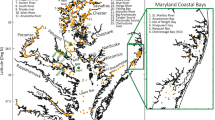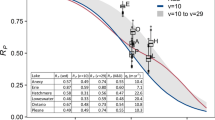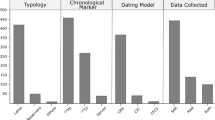Abstract
Lake sediments record the flux of materials (nutrients, pollutants, particulates) through a lake system both qualitatively, as changes in the composition of geochemical and biological tracers, as well as quantitatively, through changes in their rate of burial. Burial rates provide a direct link to contemporary (neo-) limnological studies as well as management efforts aimed at load reductions, but are difficult to reconstruct accurately from single cores owing to the spatial and temporal variability of sediment deposition in most lakes. The accurate determination of whole-lake burial rates from analysis of multiple cores, though requiring more effort per lake, can help resolve such problems and improve our understanding of sediment heterogeneity at multiple scales. Partial solutions to these problems also include focusing corrections based on 210Pb flux, co-evaluation of concentration profiles, trend analysis using multiple lakes, and trend replication based on a small number of cores from the same lake. Recent multi-core studies demonstrate that no single core site faithfully records the whole-lake time-resolved input of materials, but that as few as five well-placed cores can provide a reliable record of whole-lake sediment flux for morphometrically simple basins. Lake-wide sediment fluxes can be coupled with reconstructed outflow losses to calculate historical changes in watershed and atmospheric loading of nutrients, metals, and other constituents. The ability of paleolimnology to accurately assess the sedimentary flux and extend the period of reference into the distant past represents an important contribution to the understanding of biogeochemical processes and their response to human and natural disturbance.






Similar content being viewed by others
References
Anderson NJ (1989) A whole-basin diatom accumulation rate for a small eutrophic lake in Northern Ireland and its palaeoecological implications. J Ecol 77:926–946
Anderson NJ (1990a) Spatial pattern of recent sediment and diatom accumulation in a small, monomictic, eutrophic lake. J Paleolimnol 3:143–160
Anderson NJ (1990b) Variability of diatom concentrations and accumulation rates in sediments of a small lake basin. Limnol Oceanogr 35:497–508
Anderson NJ (1990c) Variability of sediment diatom assemblages in an upland, wind-stressed lake (Loch Fleet, Galloway, S.W. Scotland). J Paleolimnol 4:43–59
Appleby PG (2008) Three decades of dating recent sediments by fallout radionuclides—a review. Holocene 18:83–93
Appleby PG, Haworth EY, Michel H, Short DB, Laptev B, Piliposian GT (2003) The transport and mass balance of fallout radionuclides in Blelham Tarn, Cumbria (UK). J Paleolimnol 29:459–473
Balogh SJ, Engstrom DR, Almendinger JE, Meyer ML, Johnson DK (1999) A history of mercury loading in the upper Mississippi River reconstructed from the sediments of Lake Pepin. Environ Sci Technol 33:3297–3302
Balogh SJ, Engstrom DR, Almendinger JE, McDermott C, Hu J, Nollet YH, Meyer ML, Johnson DK (2009) A sediment record of trace metal loadings in the Upper Mississippi River. J Paleolimnol 41:623–639
Balogh SJ, Triplett LD, Engstrom DR, Nollet YH (2010) Historical trace metal loading to a large river recorded in the sediments of Lake St. Croix, USA. J Paleolimnol 44:517–530
Baskaran M (2011) Po-210 and Pb-210 as atmospheric tracers and global atmospheric Pb-210 fallout: a review. J Environ Radioact 102:500–513
Battarbee RW (1978a) Biostratigraphical evidence for variations in the recent pattern of sediment accumulation in Lough Neagh, N. Ireland. Verh Int Verein Limnol 20:624–629
Battarbee RW (1978b) Observations on the recent history of Lough Neagh and its drainage basin. Phil Trans R Soc Lond B 281:303–345
Belmont P, Gran KB, Schottler SP, Wilcock PR, Day SS, Jennings C, Lauer JW, Viparelli E, Willenbring JK, Engstrom DR, Parker G (2011) Large shift in source of fine sediment in the upper Mississippi River. Environ Sci Technol 45:8804–8810
Biester H, Bindler R, Martinez-Cortizas A, Engstrom DR (2007) Modeling the past atmospheric deposition of mercury using natural archives. Environ Sci Technol 41:4851–4860
Bindler R, Renberg I, Brännvall M-L, Emteryd O, El-Daoushy F (2001) A whole-basin study of sediment accumulation using stable lead isotopes and flyash particles in an acidified lake, Sweden. Limnol Oceanogr 46:178–188
Blais JM, Kalff J (1995) The influence of lake morphometry on sediment focusing. Limnol Oceanogr 40:582–588
Bloemendal J, Oldfield F, Thompson R (1979) Magnetic measurements used to assess sediment influx at Llyn Goddionduon. Nature 280:50–53
Blumentritt DJ, Wright HE Jr, Stefanova V (2009) Formation and early history of Lakes Pepin and St. Croix of the upper Mississippi River. J Paleolimnol 41:545–562
Brune GM (1953) Trap efficiency of reservoirs. Trans Am Geophys Union 34:407–418
Buth JM, Steen PO, Sueper C, Blumentritt D, Vikesland PJ, Arnold WA, McNeill K (2010) Dioxin photoproducts of triclosan and its chlorinated derivatives in sediment cores. Environ Sci Technol 44:4545–4551
Cameron NG (1995) The representation of diatom communities by fossil assemblages in a small acid lake. J Paleolimnol 14:185–223
Davis MB, Brubaker LB (1973) Differential sedimentation of pollen grains in lakes. Limnol Oceanogr 18:635–646
Davis MB, Deevey ES Jr (1964) Pollen accumulaiton rates: estimates from Late Glacial sediments of Rogers Lake. Science 145:1293–1295
Dearing JA (1983) Changing patterns of sediment accumulation in a small lake in Scania, southern Sweden. Hydrobiologia 103:59–64
Dearing JA, Elner JK, Happey-Wood CM (1981) Recent sediment flux and erosional processes in a Welsh upland lake-catchment based on magnetic susceptibility measurements. Quat Res 16:356–372
Dillon PJ, Evans RD (1982) Whole-lake lead burdens in sediments of lakes in southern Ontario, Canada. Hydrobiologia 91:121–130
Drevnick PE, Engstrom DR, Driscoll CT, Swain EB, Balogh SJ, Kamman NC, Long DT, Muir DCG, Parsons MJ, Rolfhus KR, Rossman R (2012a) Spatial and temporal patterns of mercury accumulation in lacustrine sediments across the Laurentian Great Lakes region. Environ Pollut 161:252–260
Drevnick PE, Yang H, Lamborg CH, Rose NL (2012b) Net atmospheric mercury deposition to Svalbard: estimates from lacustrine sediments. Atmos Environ 59:509–513
Edlund MB, Engstrom DR, Triplett LD, Moraska Lafrancois B, Leavitt PR (2009) Twentieth century eutrophication of the St. Croix River (Minnesota–Wisconsin, USA) reconstructed from the sediments of its natural impoundment. J Paleolimnol 41:641–657
Engstrom DR (2009) A tale of two rivers. J Paleolimnol 41:541–543
Engstrom DR, Swain EB (1986) The chemistry of lake sediments in time and space. Hydrobiologia 143:37–44
Engstrom DR, Whitlock C, Fritz SC, Wright HE Jr (1991) Recent environmental changes inferred from the sediments of small lakes in Yellowstone’s northern range. J Paleolimnol 5:139–174
Engstrom DR, Swain EB, Henning TA, Brigham ME, Brezonik PL (1994) Atmospheric mercury deposition to lakes and watersheds: a quantitative reconstruction from multiple sediment cores. In: Baker LA (ed) Environmental chemistry of lakes and reservoirs. American Chemical Society, Washington, D.C., pp 33–66
Engstrom DR, Swain EB, Balogh SJ (2007) History of mercury inputs to Minnesota lakes: influences of watershed disturbance and localized atmospheric deposition. Limnol Oceanogr 52:2467–2483
Engstrom DR, Almendinger JE, Wolin JA (2009) Historical changes in sediment and phosphorus loading to the upper Mississippi River: mass-balance reconstructions from the sediments of Lake Pepin. J Paleolimnol 41:563–588
Evans RD, Rigler FH (1980) Measurement of whole lake sediment accumulation and phosphorus retention using lead-210 dating. Can J Fish Aquat Sci 37:817–822
Evans RD, Rigler FH (1983) A test of lead-210 dating for the measurement of whole lake soft sediment accumulation. Can J Fish Aquat Sci 40:506–515
Fitzgerald WF, Engstrom DR, Lamborg CH, Tseng C-M, Balcom PH (2005) Modern and historic atmospheric mercury fluxes in northern Alaska: global sources and Arctic depletion. Environ Sci Technol 39:557–568
Foster IDL, Dearing JA, Simpson A, Carter AD, Appleby PG (1985) Lake catchment studies or erosion and denudation in the Merevale catchment, Warwickshire, U.K. Earth Surf Processes & Landfs 10:45–68
Graustein WC, Turekian KK (1986) 210Pb and 137Cs in air and soils measure the rate and vertical profile of aerosol scavenging. J Geophys Res 91:14355–14366
Heathcote AJ, Downing JA (2011) Impacts of eutrophication on carbon burial in freshwater lakes in an intensively agricultural landscape. Ecosystems 15:60–70
Heggen MP, Birks HH, Heiri O, Grytnes J-A, Birks HJB (2012) Are fossil assemblages in a single sediment core from a small lake representative of total deposition of mite, chironomid and plant macrofossil remains? J Paleolimnol 48:669–691
Hilton J, Lishman JP, Allen PV (1986) The dominant processes of sediment distribution and focusing in a small, eutrophic, monomictic lake. Limnol Oceanogr 31:125–133
Kamman NC, Engstrom DR (2002) Historical and present fluxes of mercury to Vermont and New Hampshire lakes inferred from 210Pb dated sediment cores. Atmos Environ 36:1599–1609
Kelley DW, Nater EA (2000) Historical sediment flux from three watersheds in Lake Pepin, Minnesota, USA. J Environ Qual 29:561–568
Kratz TK, Frost TM, Elias JE, Cook RB (1991) Reconstruction of a regional, 12,000-yr silica decline in lakes by means of fossil sponge spicules. Limnol Oceanogr 36:1244–1249
Lamborg CH, Engstrom DR, Fitzgerald WF, Balcom PH (2012) Apportioning global and non-global components of mercury deposition through 210Pb indexing. Sci Total Environ. doi: 10.1016/j.scitotenv.2012.10.065
Leavitt PR, Fritz SC, Anderson N, Baker P, Blenckner T, Bunting L, Catalan J, Conley D, Hobbs W, Jeppesen E (2009) Paleolimnological evidence of the effects on lakes of energy and mass transfer from climate and humans. Limnol Oceanogr 54:2330–2348
Livingstone DA (1957) On the sigmoid growth phase in the history of Linsley Pond. Am J Sci 255:364–373
Molyneux L, Thompson R (1973) Rapid measurement of the magnetic susceptibility of long cores of sediment. Geophys J R Astr Soc 32:479–481
Monteith DT, Stoddard JL, Evans CD, de Wit HA, Forsius M, Høgåsen T, Wilander A, Skjelkvåle BL, Jeffries DS, Vuorenmaa J, Keller B, Kopácek J, Vesely J (2007) Dissolved organic carbon trends resulting from changes in atmospheric deposition chemistry. Nature 450:537–541
Morales L, French J, Burningham H, Evans C, Battarbee RW (2010) Wind forcing of upland lake hydrodynamics: implementation and validation of a 3D numerical model. American Geophysical Union, fall meeting 2010 Abstract #H41F-1155
Muir DCG, Wang X, Yang F, Nguyen N, Jackson TA, Evans MS, Douglas MSV, Köck G, Lamoureux S, Pienitz R, Smol JP, Vincent WF, Dastoor A (2009) Spatial trends and historical deposition of mercury in eastern and northern Canada inferred from lake sediment cores. Environ Sci Technol 43:4802–4809
Renberg I, Wik M (1985) Soot particle counting in recent lake sediments an indirect dating method. Ecol Bull 37:53–57
Rippey B (2010) A model for the concentration of lead and polychlorinated biphenyls in lake sediment. J Paleolimnol 43:565–576
Rippey B, Anderson NJ (1996) Reconstruction of lake phosphorus loading and dynamics using the sedimentary record. Environ Sci Technol 30:1786–1788
Rippey B, Anderson NJ, Renberg I, Korsman T (2008) The accuracy of methods used to estimate the whole-lake accumulation rate of organic carbon, major cations, phosphorus and heavy metals in sediment. J Paleolimnol 39:83–99
Rose NL (1994) A note on further refinements to a procedure for the extraction of carbonaceous fly-ash particles from sediments. J Paleolimnol 11:201–204
Rose NL (2007) The sediments of Lochnagar: distribution, accumulation and composition. In: Rose NL (ed) Lochnagar: the natural history of a mountain lake. Springer, Dordrecht, pp 155–175
Rose NL, Yang H (2007) Temporal and spatial patterns of spheroidal carbonaceous particles (SCPs) in sediments, soils and deposition at Lochnagar. In: Rose NL (ed) Lochnagar: the natural history of a mountain lake. Springer, Dordrecht, pp 403–423
Rose NL, Harlock S, Appleby PG, Battarbee RW (1995) Dating of recent lake sediments in the United Kingdom and Ireland using spheroidal carbonaceous particle (SCP) concentration profiles. The Holocene 5:328–335
Rose NL, Harlock S, Appleby PG (1999) Within-basin profile variability and cross-correlation of lake sediments cores using the spheroidal carbonaceous particle record. J Paleolimnol 21:85–96
Rose NL, Yang H, Turner SD, Simpson GL (2012) An assessment of the mechanisms for the transfer of lead and mercury from atmospherically contaminated organic soils to lake sediments with particular reference to Scotland, UK. Geochim Cosmochim Acta 82:113–135
RoTAP (2012) Review of transboundary air pollution: acidification, eutrophication, ground level ozone and heavy metals in the UK. Contract report to the Department for Environment, Food and Rural Affairs, Centre for Ecology and Hydrology
Rowan DJ, Kalff J, Rasmussen JB (1992) Estimating the mud deposition boundary depth in lakes from wave theory. Can J Fish Aquat Sci 49:2490–2497
Rowan DJ, Cornett RJ, King K, Risto B (1995a) Sediment focusing and 210Pb dating: a new approach. J Paleolimnol 13:107–118
Rowan DJ, Rasmussen JB, Kalff J (1995b) Optimal allocation of sampling effort in lake sediment studies. Can J Fish Aquat Sci 52:2146–2158
Smol JP (2008) Pollution of lakes and rivers: a paleoenvironmental perspective. Blackwell, Oxford
Swain EB, Engstrom DR, Brigham ME, Henning TA, Brezonik PL (1992) Increasing rates of atmospheric mercury deposition in midcontinental North America. Science 257:784–787
Thompson R, Battarbee RW, O’Sullivan PE, Oldfield F (1975) Magnetic susceptibility of lake sediments. Limnol Oceanogr 20:687–698
Triplett LD, Engstrom DR, Conley DJ, Schellhaass SM (2008) Silica fluxes and trapping in two contrasting natural impoundments of the upper Mississippi River. Biogeochemistry 87:217–230
Triplett LD, Engstrom DR, Edlund MB (2009) A whole-basin stratigraphic record of sediment and phosphorus loading to the St. Croix River, USA. J Paleolimnol 41:659–677
Triplett LD, Engstrom DR, Conley DJ (2012) Changes in amorphous silica sequestration with eutrophication of riverine impoundments. Biogeochemistry 108:413–427
Vukić J, Appleby PG (2003) Spheroidal carbonaceous particle record in sediments of a small reservoir. Hydrobiologia 504:315–325
Yang H, Rose NL, Battarbee RW, Boyle JF (2002a) Mercury and lead budgets for Lochnagar, a Scottish mountain lake and its catchment. Environ Sci Technol 36:1383–1388
Yang H, Rose NL, Battarbee RW, Monteith D (2002b) Trace metal distribution in the sediments of the whole lake basin for Lochnagar, Scotland: a palaeolimnological assessment. Hydrobiologia 479:51–61
Acknowledgments
This review is dedicated to the scientific career of our friend and colleague, Rick Battarbee, whose research, mentoring, and leadership have so greatly advanced the field of paleolimnology. Funding for the work at Lochnagar was partially supported by the Department for Environment, Food and Rural Affairs (then DETR) and the EU MOLAR project (contract No. ENV4-CT95-0007). The other work on Scottish lake metals was funded as part of Eurolimpacs (Integrated Project to evaluate the Impacts of Global Change on European Freshwater Ecosystems) (Project No. GOCE-CT-2003-505540). Work on lakes Pepin and St. Croix of the upper Mississippi River was supported by the Minnesota Pollution Control Agency, the Metropolitan Council Environmental Services, and the US National Park Service.
Author information
Authors and Affiliations
Corresponding author
Rights and permissions
About this article
Cite this article
Engstrom, D.R., Rose, N.L. A whole-basin, mass-balance approach to paleolimnology. J Paleolimnol 49, 333–347 (2013). https://doi.org/10.1007/s10933-012-9675-5
Received:
Accepted:
Published:
Issue Date:
DOI: https://doi.org/10.1007/s10933-012-9675-5




